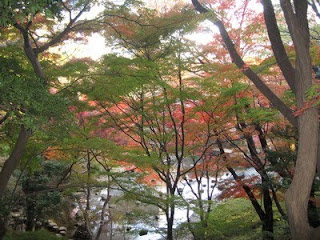Defray ... defla- ... or as it is know in English deflation is the media buzz word at the moment. The Japanese govt. announced last week that the Japanese economy is back in a deflationary state. I could have told them that without relying on a report.
The other day NHK (the national broadcasters) recited a litany of price reductions.
Average natto (fermented beans) price - down 10%
Average shampoo price - down 20%
Bottled water price - down 30%.
I don't remember the others.
Last night we were out and hot cans of oshiruko - a sweet red bean soup - were 50 yen! That's about 55c Aus for a can of drink. The cans are small, the same size for coffee, but usually sell for 120Y - at least the coffee does. The other day in Niigata Lily bought 2 bokchoy for 30 yen for the two of them and a big bag of veges for about 1200 Y.
It's utterly mad with much pricing that is totally unsustainable.
I am no economist, but there is
some logic to the long term situation of deflation.
- Salaries have been cut (Hokkaido govt. 2 years ago cut all employees salaries by 10%), bonuses - which are built into a full time workers expected salary - are being withheld or cut, and new staff are more likely to be employed on a part time basis.
- immigration policy is also, I suspect, pushing wages in many sectors down - unlike Australia where most immigrants, at least traditionally, plan to live in Australia in the future, Japanese immigration seems to have a high percentage of people here for short term work. Guest worker schemes seem to work in some places, notably Singapore and Dubai, here I think it's probably reasonable to conclude it contributes to overall wages being pushed down. (I will investigate this further and perhaps in the future write in more detail - immigration statistics are difficult to draw conclusive opinions from.) There are also large numbers of people coming on short term visas in skilled industry, who can afford to work for less because they are saving for a future in a much cheaper country. Unlike most developed countries, Japan does not really have a policy of encouraging permanent immigration which may help stimulate the economy. (this should be qualified in the pursuit of accuracy, however it's too tangental for this post.)
- Most goods are now manufactured in China or SEAsia rather than domestically.
- Many food stuffs are now being imported from other parts of Asia
- Clothing manufacture has moved to mass production and large chain store sales reducing the cost
- Chain operators now dominate cheaper restaurants - their ingredients are sourced from overseas and they employ few full time staff.
- the population is falling - fewer people, less demand.
- the population is aging rapidly - people in their 80s and 90s are low consumers of most thing aside from healthcare and medicine.
- interest rates are less than one percent - no scope for interest reduction to stimulate the economy.
- banks are leery of lending money to anyone that could be a risk - partly due to banks making such poor lending decisions in the past.
- Japanese propensity to save rather than spend. (credit card use is quite minimal here - the other day I was at H&M and of the six people ahead of me buying clothes, all 6 paid in cash (and me made 7).
- Japanese propensity to save with an emphasis on low risk - a non yielding bank account rather than stocks etc (currency trading has been popular recently, though it seems a lot of people have been burned)
- cut price chains moving into bloated industries eg funeral industry which is traditionally obscenely expensive (partly because most temples operate as businesses rather than as non profit organisations).
Last night's news showed a meeting of retired JAL staff who are having their pension entitlements, which were presumably set during the bubble economy and when JAL was massively profitable, cut. The retirement pension amount will still be about 70% higher than the now average salary.
This story was followed by the surge in loan sharking on people falling behind in rent payments.
I will need to ponder a bit longer to come up with any constructive suggestions, but some constructive suggestions are sorely needed. The future of a Japan that appreciates cheapness at the expense of skill or beauty or workmanship is rather grim.
Vending machine with 50Y oshiruko, 80Y corn soup, 100 coffee.
Blue background behind the price shows it is cold, a red background shows that it is a hot drink.
Usually these drinks sell for 120Y.





































